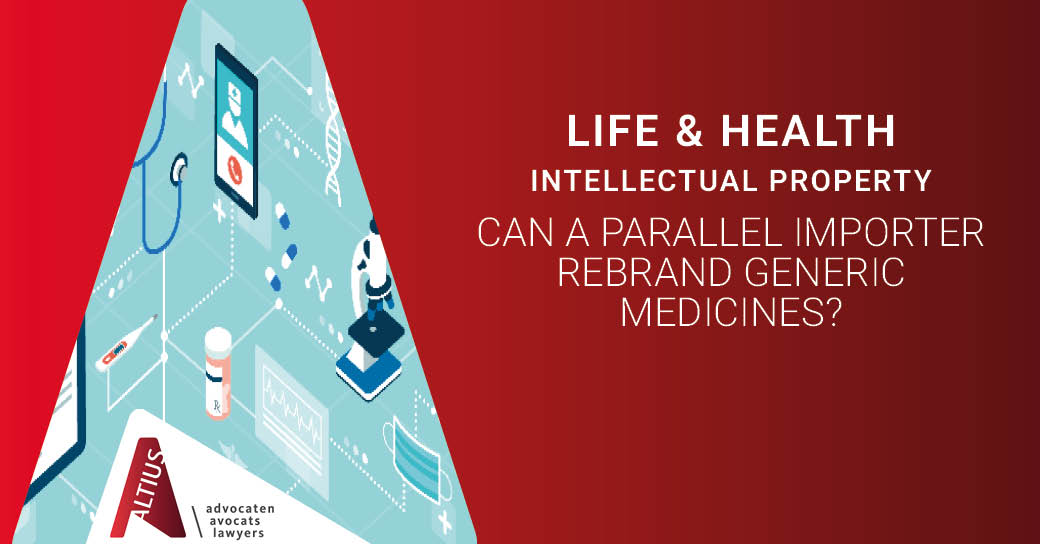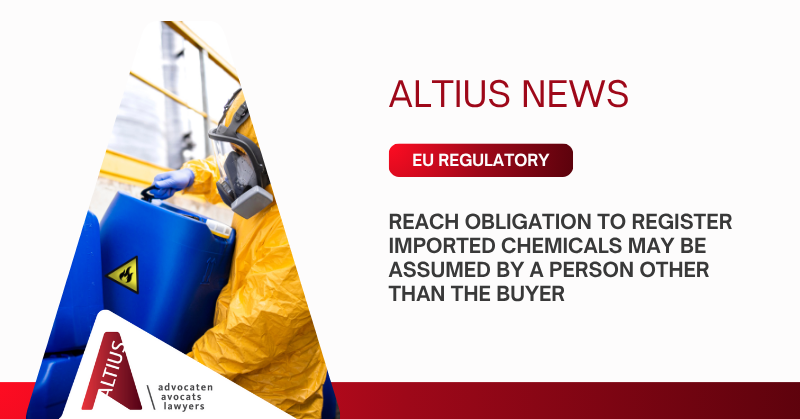Can a parallel importer rebrand generic medicines?

If a branded medicine and its generic version are put on the EEA market by economically-linked undertakings, is a parallel importer then allowed to rebrand and repackage the imported generic version as the branded reference medicine? This has been a hotly-debated issue in recent years, and has led the Brussels Court of Appeal to recently refer three questions to the Court of Justice of the European Union (cases C-253/20 and C-254/20). In anticipation of the Advocate-General’s opinion and the CJEU’s ruling, this blogpost provides the factual background and explains why a parallel importer should in our view not be allowed to rebrand in such a case just to have the best of both markets.
Background to the dispute
In May 2020, the Brussels Court of Appeal (‘CoA’) referred its three questions for a preliminary ruling to the Court of Justice of the European Union (‘CJEU’) in two cases where parallel imported generic medicines were rebranded and repackaged as the branded reference medicine. Both cases involve the commercialisation in Belgium of branded products of the Swiss pharmaceutical company, Novartis, following the parallel import from the Netherlands of generic products of Novartis’ generic division, Sandoz.
In the first case (C-253/20), Impexeco, a parallel importer, intended to import the generic, Letrozol Sandoz, from the Netherlands into Belgium as Novartis’ branded reference medicine, Femara®. In the second case (C-254/20), PI Pharma, another parallel importer, tried to do the same for the generic, Methylfenidaat HCl Sandoz, to commercialise it as Novartis’ branded reference medicine, Rilatine®.
Therefore, the background was very similar in both cases. The reference medicine and generic version were bio-equivalent, shared the same therapeutic indications and were commercialised in both Belgium and the Netherlands. The parallel importers had obtained a parallel import authorisation from the Belgian Federal Agency for Medicines and Health Products. The crux was that the parallel importers also sought to affix Novartis’ respective trade marks for Femara® and Rilatine® on products that had not been marketed with those trade marks.
Belgian case law
Over the past years, in addition to the two cases above, several cases have resulted in contradictory decisions regarding the issue of whether parallel importers can rebrand and repackage the imported generic version as the branded reference medicine.
In the proceedings that led to the CoA’s referral decisions,[1] the President of the Dutch-language Brussels Enterprise Court considered the parallel importers’ actions as infringing Novartis’ trade mark rights and imposed injunctions on the parallel importers.[2] The first instance decisions were based on two different grounds:
- First, Novartis’ trade mark rights were not exhausted. According to Article 15(1) EUTMR,[3] trade mark rights are only exhausted for goods that have been put on the market in the EEA under that trade mark by or with the proprietor’s consent. Given that the trade mark had not been used by Novartis on the generic products marketed by Novartis and bought by the parallel importer in the Netherlands, exhaustion did not apply.
- Second, the parallel importers’ use of the trade mark of the branded medicine was not justified by virtue of the free movement of goods, given that Novartis’ reliance on its trade mark rights did not artificially partition the Belgian market. That is because artificial partitioning indeed requires that the product market is actually entirely identical, whereas generic medicines and branded medicines actually belong to distinct market segments. The existence of different market segments is an economic reality resulting from the system of (lapsed) patent protection, and also follows from a regulatory and medical point of view, a different public perception and differences in pricing and reimbursement. Preventing the parallel importer from entering the originator market with a product from the generic market therefore does not constitute artificial partitioning of a market.
As a result, the parallel importers’ use of Novartis’ trademark was not justified by the rules on exhaustion or the free movement of goods and were held to amount to a trade mark infringement.
These decisions contradict earlier rulings by the President of the Brussels Enterprise Court dating back to 2015,[4] regarding (again) the rebranding of Letrozole Sandoz to Femara® and Valsartan Hydrochlorothiazide Sandoz to Co-Diovane®. In those rulings, the President came to the opposite conclusion holding that (i) Novartis’ trademark rights were in fact exhausted, and (ii) Novartis’ reliance on its trade mark rights led to artificial partitioning of the market given that there were no separate market segments. This conclusion was based on the considerations that (i) in one of the cases, the generic product was not commercialised in Belgium; (ii) health care practitioners did not often prescribe medicines on the basis of the compound name; and (iii) the name of the generic medicine was little known so that ‘reminder advertising’ by the parallel importer would be of little use.
Questions referred for a preliminary ruling
Due to the diverging case law at the first instance level, the Brussels CoA’s judgment on this issue was highly anticipated. The CoA set out the parties’ positions regarding the issues above and referred to the fact that the legal question had been answered in various ways. Therefore the CoA felt that there was considerable controversy and uncertainty as to whether the trade mark holder could indeed oppose the rebranding by a parallel importer of a generic to an originator product, where both products had been marketed in the EEA by economically-linked companies.
The literal questions can be consulted here and here, and are in essence as follows:
- Where economically-linked undertakings have put a branded reference medicine and a generic medicine on the EEA market, may a trade mark proprietor’s opposition to the parallel importer’s commercialisation of the generic medicine, after the parallel importer has repackaged and rebranded it as the branded reference medicine, lead to an artificial partitioning of the markets of the Member States?
- If so, must this be assessed under the BMS conditions?
- Is the above affected by the fact that the generic medicine and branded reference medicine are identical or have the same therapeutic effect?
Conclusion
The CJEU will decide on the questions above and its decision can be expected to have a considerable impact on the parallel trade of medicines.
Particularly relevant for what is the first and, in our view, also the essential question (i.e. is there artificial partitioning of the market) is the fact that the generic product is commercialised in the country of exportation as well as the country of importation. The parallel importers could therefore just as well import the generic product as the reference product in Belgium.
The argument that generic medicines and their branded counterparts belong to one and the same market, seems in our view unconvincing. The parallel importers’ desire to rebrand the generic medicines and commercialise them at the higher price of the reference medicine implicitly shows that parallel importers also perceive two markets.
The CJEU is expected to decide within the next twelve months whether parallel importers can actually have it both ways.
[1] Brussels CoA 25 May 2020, 2018/AR/1027 and 2018/AR/858, consultable on curia.europa.eu.
[2] President Dutch-language Brussels Enterprise Court 12 April 2018, A/17/20, Jb. Markt, 2018, p. 697; President Dutch-language Brussels Enterprise Court 12 April 2018, A/17/2678, unreported.
[3] Regulation (EU) 2017/1001 of the European Parliament and of the Council of 14 June 2017 on the European Union trade mark (‘EUTMR’). At the time of the first instance judgment, Council Regulation (EC) No 207/2009 of 26 February 2009 was still in force and applied.
[4] President Dutch-language Brussels Enterprise Court 4 March 2015, A/14/51314, unreported; President Dutch-language Brussels Enterprise Court 18 March 2015, A/14/51314, unreported.
Written by
Recommended articles
Combination therapies in Belgium: how to collaborate without breaching competition law
As the landscape of modern medicine evolves, combination therapies—those that use two or more distinct medicines, often from different companies—are becoming increasingly vital, especially in treating complex diseases like cancer. These therapies promise improved clinical outcomes through synergistic mechanisms of action. However, the reimbursement process for such therapies presents significant regulatory and legal challenges, particularly […]
Read onTitanium dioxide: General Court strikes down classification as human carcinogen and ECJ now confirms
The European Commission often relies on scientific evidence for its regulatory decisions. But when challenged, how much deference is owed to the regulator’s interpretation of the underlying science?
Read onREACH obligation to register imported chemicals may be assumed by a person other than the buyer
Under the EU’s REACH Regulation 1907/2006, substances must be registered with the European Chemicals Agency before being imported. The duty to register lies with the importer. In practice, the act of ‘importing’ often involves multiples actors, including the seller, the buyer and various intermediaries who move the goods across borders. So, who then should register […]
Read on


